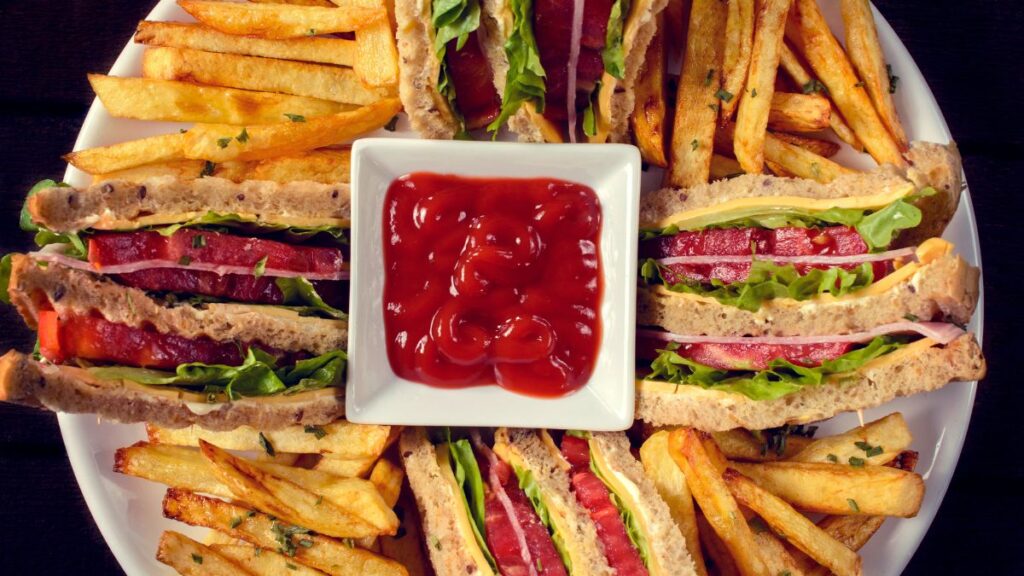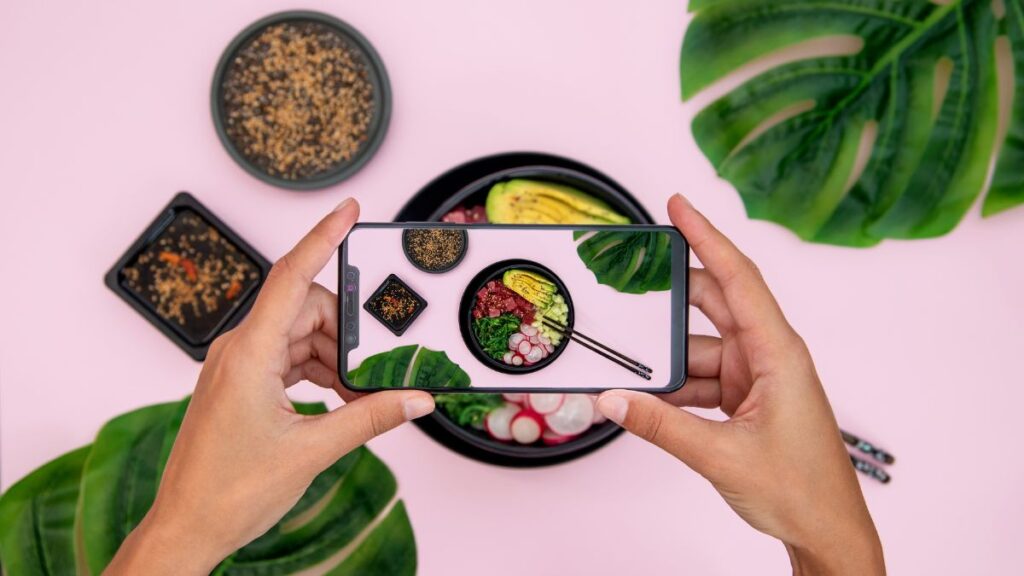Introduction – The Flavorful Diet: 2025 and beyond
Popular food trends 2025 is more than just survival. Today’s customer demands more than mere sustenance — they’re hungry for story, novelty, and a journey of the senses. The lines between food and art, health and indulgence, tradition and technology are being erased, and the result is a culinary landscape that is vibrant and abundant.

If anything, this year, food is even bolder. 2025 New Age-inspired flavors ignite our vises and dishes co-created by artificial intelligence offer a Rabelaisian orgy of fearless exploration. Every plate represents: how to live fully, how to eat thoughtfully, how to embrace the new while honoring the past.
A Year of Culinary Exploration
Why 2025 is the age of bold, adventurous bites
The word “safe” has largely dropped out of the dining lexicon. Diners are game for surprises, even pokes in the belly. They want taste buds pushed into the unknown (heat, tang, umami) and textures confounded. It’s not just about how a plate tastes; it’s appreciated for how it makes us feel.
Chefs have taken this lead to be unapologetically themselves. “I love the juxtaposition of sweet and savory in desserts and as garnish — you’ll see herbs topping desserts,” she says—sour and smoky flavors march hand in hand in cocktails. In 2025, the gold standard isn’t a gimmick — it’s boldness.
How global forces are reshaping everyday dining
The world has never had so much cheap grain and cheap food in its pantry. Spices that were once journeyed over mountains and deserts for months on the Silk Road now land on our doorsteps with a click. Streaming services deliver Seoul, Lagos, or Lima cooking straight into living rooms, inspiring adventurous palates.
So it is no surprise that a weeknight dinner in a suburban kitchen might involve berbere-spiced lentils, Japanese miso soup, and a Mexican-inspired dessert. CASUAL dining has become a passport to the world. Eating is the one thing that links us across continents, and by 2025, global flavors will be more than just trends — they’ll be entrenched.
Plant-Powered Evolution
Rise of next-gen plant-based proteins
Plant-based dining isn’t an alternative anymore; it’s the main event. Advances in precision fermentation and cellular agriculture have made plant proteins of 2025 far more realistic as well, with texture, juiciness, and depth of flavor that compete with old-fashioned meats. Chickpeas take on a seafood-like texture, and fungi are designed to mimic the complexity of beef.
Two burning issues, health and sustainability, are answered through these innovations. Diners who once recoiled at “fake meat” eagerly consume this stuff because the products taste just like the real thing and satisfy that old craving with no cutting of corners. What felt futuristic is just food.
Innovative items that are more than burgers and nuggets
The inventive failure isn’t confined to substitution. Chefs are making food that honors plants for what they are, not what they can replace. Consider how it sounds to snack on roasted carrot “ribs” lacquered in smoky sauces, to bite into jackfruit birria tacos dripping with pungent spices, or to fork beet tartare with a chunk of sourdough.
2025: Plant-based dining is officially past imitation — and onward to elevation. So diners don’t leave saying, “That tastes like meat,” but rather, “That was memorable.”
Fusion Without Borders
Unexpected pairings dominating 2025 menus
In restaurants worldwide, menus now display pairings that would once have been unimaginable. Quesadillas are filled with kimchi, brisket glazed with tamarind and saffron, and ramen is wedded together in dishes that straddle cultures as though it were an act of nature. These are not stunts; they’re considered experiments in flavor harmony.
The surprise is an exciting way to keep diners interested. One bite could bring a wisp of Southeast Asian spice, the next, a taste of smoky Southern comfort. These sorts of dishes demand exploration and blur the lines between comfort and the unfamiliar.
Cultural mashups redefining comfort food
Comfort food is evolving, too. The timeless, heartwarming classics we all love are now global in accent. Fried chicken, for example, could reappear with Japanese karaage crunch, be seasoned with Moroccan ras el hanout. Pasta, traditionally an Italian dish, is now brightened with Caribbean jerk spices.
The mashups here argue that comfort is not a static condition. It changes with culture, migration, and memory. In 2025, comfort food is what we eat now, and it defines not only who we are but where we are going.
Tech Meets Taste
Bright kitchens for smarter meals
Technology has infiltrated kitchens with hardly a ripple. Artificial-intelligence ovens modulate the temperature in the middle of a bake for perfect cakes. Refrigerators keep up with expiration dates and recommend recipes to minimize food waste. Molecular gastronomy kits or sous-vide precision tools, gadgetry that once only professionals had access to, can now be in any home cook’s arsenal.

The result? More intelligent meals that require less guesswork and yield more consistency. Cooking is less about fear and more about empowerment, and now everyone has access to culinary creativity.
AI-driven recipes shaping personalized dining
It’s not just helping us cook; it’s helping us decide what to cook. Algorithms can now recommend what to have for dinner simply based on mood, dietary restrictions, or what’s in the weather—hankering for comfort on a rainy day? An AI may suggest a saffron-infused soup. Feeling energetic? Maybe even a poke bowl full of adaptogens.
Personalization has reached new heights. There’s no reason two diners should ever eat the same incarnation of a dish again. In 2025, food is as personalized as the individual consuming it.
Sustainability on the Plate
Zero-waste dining is becoming mainstream.
Waste is no longer acceptable. Both chefs and home cooks are constantly inventing new ways to use every scrap. Carrot greens go into pesto, coffee grounds take new life as marinades, and fruit peels get candied into bright garnishes. This has gone from niche activism to mainstream practice.
Zero-waste dining also sparks creativity. Combining limitations, chefs unearth new flavors and textures. Diners are as well off with menus that feel fresh, resourceful, and deeply rooted in the world of the planet.
Upcycled ingredients finding gourmet status
That upcycling, once derided as trendy, has become gourmet. Brewer’s spent grain is transformed into artisanal bread; leftover cocoa husks become rich, fragrant teas. Without a doubt, these ingredients have been raised in status or at least on an equal footing in our gastronomy, and are being appreciated for their sustainability and flavor profiles.
In 2025, diners see upcycled foods as not “less than,” but as luxuries that bear stories of innovation and care.
Hyper-Local Ingredients
Community-driven sourcing from rooftop farms
Cities are getting greener from the top down. Rooftop gardens, vertical farms, and micro-greenhouses provide restaurants with herbs and vegetables plucked mere minutes before service. Diners are experiencing a level of freshness they cannot get anywhere else, and restaurants are building relationships in their communities.
The hyper-local trend has the potential to shorten supply chains and minimize environmental impact. At the same time, it stokes the romance of knowing precisely where one’s food comes from.
Indigenous flavors are taking center stage.
Not all culinary innovation is about looking forward; sometimes it’s about looking back. Indigenous ingredients and cooking traditions are being researched and celebrated. Ancient grains like amaranth, teff, and heritage grains bring depth and variety to contemporary menus, as ancestral spices and preparation methods regain respect.
This revival not only expands palates but also gives cultural histories their due, too often undervalued. It is 2025 and “rediscovered curiosities” are no longer the purview of those whose ideas are inspired by the crisper drawer at the back of a second-tier chef’s refrigerator — not “complete dishes” that are (yes) strong when united with this wine that no one’s ever heard of, but rather components, the last Twinkie at the back of a Cheyenne, Wyo., convenience store meant to disintegrate the stereotype that Arab food is what I had last night.
Global Spice Renaissance
Fiery blends are making a comeback.
It is no longer hiding in the background. Fireball spice mixes — like berbere, harissa, and Kashmiri chili — hold sway on menus, not only bringing intensity but also deepening the flavor. Diners are drawn to the thrill of heat, looking for dishes that awaken, not dull.
The return of brave spices is not for shock value but balance. Heat marries perfectly with sweetness, acidity, and umami, all coming together for flavors that are complex and lingering.
The spice routes of antiquity and their mark on today’s kitchens
These are the spices that link us to centuries of trade, travel, and cultural cross-pollination. Each sprinkle’s a tale of humanity’s collective craving for flavor.
Functional Foods With Benefits
Immunity-boosting recipes beyond supplements
Food is emerging as medicine, but without the sterile packaging of pills. Turmeric lattes, reishi mushroom soups, and elderberry desserts provide comfort with a side of immunity. Diners are selecting dishes that feel indulgent but that also build health.
It’s not about what’s missing, it’s about adding things in (things that are enjoyable and also because you know are good for you).
Energy and mood-enhancing meals
Menu items are interspersed with dishes meant to refresh and elevate. Adaptogens, such as ashwagandha, and nootropic ingredients, including lion’s mane, are being incorporated into daily meals, alongside vitamin-dense superfoods. Functional flair infuses breakfast bowls, smoothies, and even pastas.
Food has translated into another form of self-care, merging pleasure with purpose.
Seafood Reinvented
Sustainable sea greens: kelp and algae
The sea provides more than fish. Sea greens like kelp, spirulina, and nori are known for having that savory, umami flavor and being nutrient-packed. Kelp noodles and snacks made from algae aren’t just trendy — they are staples.

These foods also come with a promise of sustainability, to heal marine ecosystems and ease pressure on conventional fishing.
Alternative ocean proteins making waves
Lab-grown seafood has marched boldly onto the table. From farmed salmon to responsibly farmed shellfish, these breakthroughs mean that seafood lovers can feast without emptying the seas.
The result is a brave new world of “catch of the day,” one that reconciles taste with responsibility.
The Return of Fermentation
Kombucha, kimchi, and brave new recipes
Fermentation is now in the midst of a significant moment. What seemed new and exotic has become routine. And with kombucha cocktails and kimchi-drenched dumplings interspersed among junk food entries, fermented foods provide tangy, multifactorial flavors that stimulate taste buds.
Microbial magic for gut-friendly flavor
The seductions of fermentation aren’t simply about taste — it’s also about health. Friendly-to-the-gut probiotics now find their way into everyday meals, which allows them to be both indulgent and restorative. Customers savor flavor while nourishing their microbiome.
Snacking Reimagined
Mini luxury in 2025, snack culture?
Snacks have evolved from a necessity to fill your belly to a treat you indulge in. Everything from the minuscule truffle sliders to saffron flavor in popcorn and bite-sized charcuterie cups takes snacking upmarket.
Protein-packed, nutrient-dense treats
Convenience is still key, but now it’s attached to nutrition. Spirulina bars, cricket-protein chips, and hemp-seed bites provide a mix of taste and nutritional value. Snacking is now about thriving, not just getting through.
Artisanal Beverages
Botanical cocktails are stealing the spotlight.
Cocktails in 2025 are glassfuls of edible gardens. Each sip feels like an exploration.
Complex-flavored non-alcoholic brews
The sober-curious movement has matured. Non-alcoholic spirits, beers, and wines are competitive with their boozy counterparts in terms of depth and complexity. No longer do we need to be drunk to celebrate, only flavor and intention!
Desserts With a Twist
Savory sweets challenge expectations
Desserts are rewriting the rules. Miso caramel, Parmesan gelato, and chili-chocolate illustrate that sweet and savory can get along swimmingly. They proved surprising and delightful, lingering in the memory.
Global-inspired desserts are gaining traction.
From Turkish baklava hybrids to Japanese mochi donuts, desserts are now a patchwork of global inspiration. Sweetness has become a common language of culture.
Bold Presentation Styles
Dining as a visual spectacle
Plates have become canvases, and chefs are artists. Smoke, edible flowers, and dramatic toppers heighten meals into multisensory adventures.
Interactive food experiences, from home to restaurants
Food is not simply served — it’s an experience. And build-your-own plates, augmented reality menus, and edible puzzles beg for interaction. Dining is play, conversation, and memory-making.
Health Meets Indulgence
Decadence balanced with mindful ingredients.
Guilt-free luxury needn’t be an oxymoron. Quinoa is paired with truffle oils, butter is exchanged for avocado, and desserts feature coconut sugar without diminishing creaminess. Pleasure is now in bed with well-being.
Low-sugar, high-flavor alternatives
There’s also an explosion of sugar alternatives, such as monk fruit, dates, and yacon syrup, which reframe sweetness. Desserts fulfill cravings and health, proving that pleasure can walk in hand-in-hand with prudence.
The Rise of Experiential Dining
Pop-up feasts with immersive storytelling
Dining has become theater. Pop-up experiences tell stories through meals, where each course is a chapter. Guests do not merely eat — they travel through story.
Take a trip through the world of food without ever leaving town
Urban eateries serve “trips” through special menus inspired by distant destinations. One night may take diners to Peru, the next to Vietnam. Food is increasingly the most democratic passport.
Digital Food Culture
Social media and the flame-feeding of food trends
A regional dish can become a global phenomenon in a day. VIRALITY is a must-have element of culinary success now.
The Instagram-ified aesthetics of plating
The camera in mind, Chefs design for the camera, prioritizing in-your-face colors, textures, and symmetry. Each plate is a dish and a digital magnum opus.
Generational Influences
Gen Z drives hunger for authenticity.
Gen Z desires transparency and realness. They want to know where ingredients come from, who produces them, and how sustainable they are. That’s what feels luxurious to this generation: authenticity.

Millennials are driving eco-conscious eating.
Eco-conscious dining is alive and well thanks to Millennials. From earth-friendly packaging to meatless options, they are leading the food industry to be more accountable.
Affordable Luxury in Everyday Meals
Premium flavors on a budget
As far as cuisine is concerned, luxury has stopped being exclusive to high-end kitchen service. Fries get caviar, pasta is enriched with truffle oil, and humble rice bowls are brightened by saffron. High-end flavors are democratized.
How humble chunks make it big
Innovative sourcing and creative techniques mean that boldness is now affordable. What was once a rarity is now accessible, a system that allows indulgence for the masses.
Final Thoughts: The Flavors That Will Define Tomorrow
Why bold may be the future of flavor
Boldness is not a trend; it’s a culture shift. People looking to eat out want something new, an adventure, and authenticity. Food has become a domain in which daredevils and the daft are rewarded.
How 2025 food trends will influence dining for years to come
The dining landscape is undergoing a sea change, and the waking nightmare will ripple into the new year. The food trends of 2025 are not passing fashions; they are the cornerstones of a much more aware, adventurous, and connected dining future. From plant-driven products to hyper-local sourcing, these moves are recalibrating what it means to eat well.
A bold experimentation of flavour, fueled by global fusion, will still blur borders into a common culinary tongue. Sustainable practices — upcycled ingredients, zero-waste cooking — will redefine what both chefs and eaters expect, providing responsibility in every bite. Functional foods (those with benefits such as mood enhancement, energy boosting, or immunity support) will further help blur the line between wellness and indulgence, so your nourishment will get that much more well-rounded.

Technology’s role is equally pivotal. Bright kitchens and AI-assisted recipes mean personalization is standard, and meals are consequently efficient, tailored, and imaginative. Meanwhile, immersive dining experiences and visually arresting presentations will turn eating into an art form, where the storytelling is as important as the taste.
In the end, the hot food trends 2025 are flagbearers showing the way to an eating culture that is free-spirited but conscious, opulent but accessible, and extremely wired to the higher values of a global generation.
<script type="application/ld+json">
{
"@context": "https://schema.org",
"@type": "BlogPosting",
"mainEntityOfPage": {
"@type": "WebPage",
"@id": "https://derstefashionist.com/popular-food-trends-2025-that-are-changing/"
},
"headline": "Popular Food Trends 2025 That Are Changing How We Eat",
"description": "Popular food trends 2025 is more than just survival. Today’s customer demands more than mere sustenance — they’re hungry for story, novelty, and a journey of the senses. The lines between food and art, health and indulgence, tradition and technology are being erased, and the result is a culinary landscape that is vibrant and abundant.",
"image": "https://derstefashionist.com/wp-content/uploads/2025/09/popular-food-trends-2025-2.jpg",
"author": {
"@type": "",
"name": "Edna Murdock",
"url": "https://derstefashionist.com/about-us-2/"
},
"publisher": {
"@type": "Organization",
"name": "Edna Murdock",
"logo": {
"@type": "ImageObject",
"url": "https://derstefashionist.com/wp-content/uploads/2025/10/cropped-cropped-cropped-store.png"
}
},
"datePublished": "2025-09-04",
"dateModified": "2025-10-10"
}
</script>
